PHARRELL WILLIAMS
The 10 Most Important Hip-Hop Sneaker Collaborations Of All Time

Straight up, streetwear wouldn’t exist if it wasn’t for hip-hop. The two entities go hand-in-hand, pushing up against and off of one another in their steady quest to take over the world. That’s not hyperbole, streetwear and hip-hop have taken over the world. Hip-hop went from a niche genre that was written off as a fad in the late ’70s and early ’80s and blossomed into a phenomenon that has since influenced every other genre of American music (see autotune country) and become the dominant musical genre of cultural expression in America. Streetwear similarly went from being a niche fashion aesthetic to a world-dominating force in modern fashion. Whether you’re a small fashion label just getting started, or an iconic luxury house like Gucci or Louis Vuitton, if you’re not designing streetwear, you’re not connecting with the people.
Streetwear and hip-hop haven’t just been growing parallel to one another, they feed off of one another. Hip-hop provides the face, streetwear provides the look, and the two entities rely on one another to move product. So it shouldn’t come as a surprise that some of the best sneakers (arguably the emblem of streetwear itself) have a rapper’s name attached. In a celebration of hip-hop and streetwear, we’re running through the most important hip-hop sneaker collaborations of all time, starting with…
Adidas Superstar, 1986
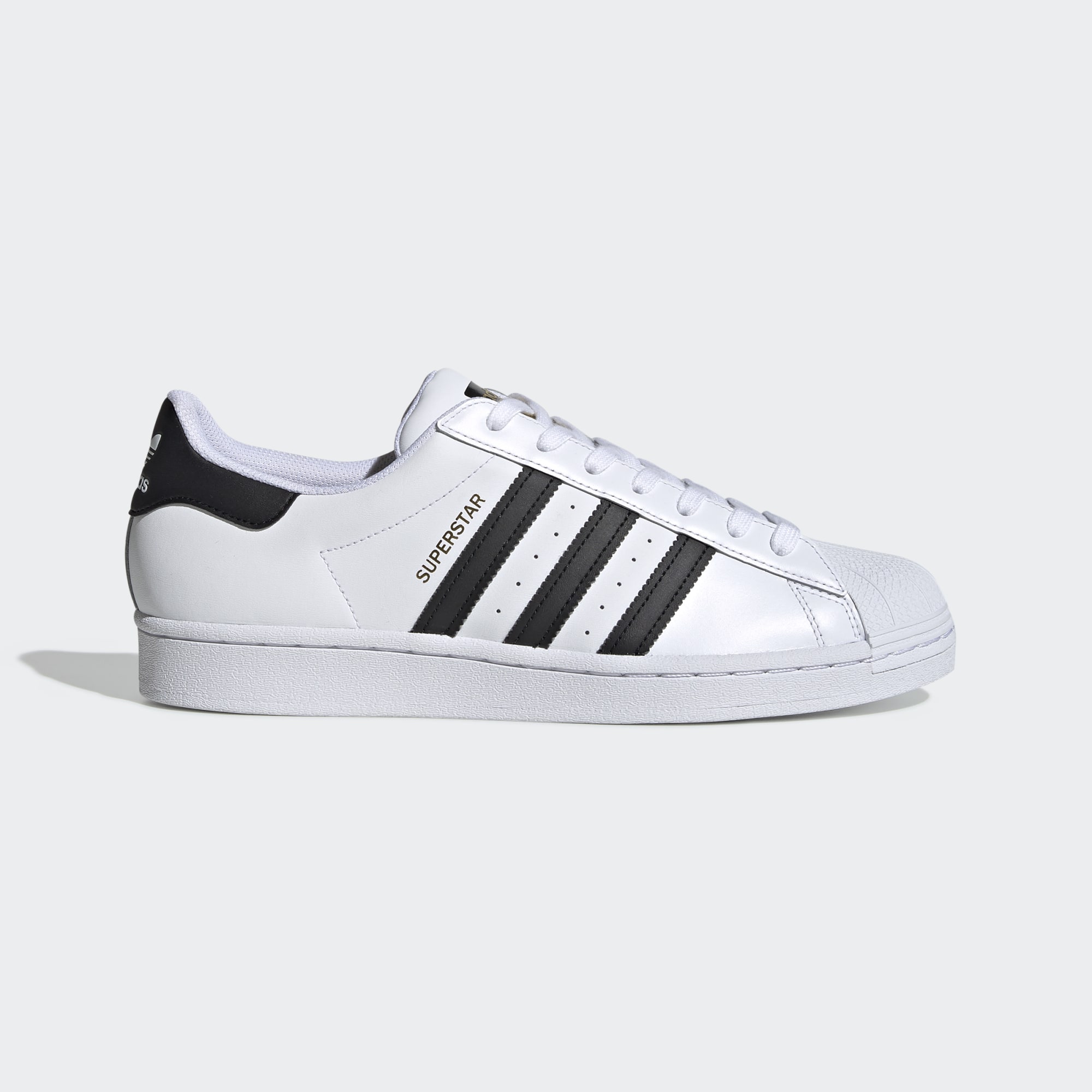
The Adidas Superstar is not technically a hip-hop sneaker collaboration, but because of Run-DMC’s hit single “My Adidas,” it felt wrong to start this list anywhere else. Make no mistake, a fresh white pair of Adidas Superstars with contrasting stark black stripes is a look wholly owned by Run-DMC Streetwear fans treat this sneaker silhouette and colorway as a stone-cold classic, and Adidas has “My Adidas” to thank for that.
The song’s video gave the world its first glimpse of hip-hop’s new look and from “My Adidas” on, the two entities have been in lock-step. The sneaker features a leather base with a shell toe cap, it’s one of Adidas’ oldest and best-selling sneaker silhouettes. Adidas would go on to let Run-DMC design their own version of the silhouette, but nothing beats the OG.
Nike Dunk High Wu-Tang, 1999

No other rap group quite understood the synergy between streetwear and hip-hop like the Wu-Tang Clan, who went off and started their very own successful streetwear label, Wu-Wear. In 1999 Nike tapped them with a special Friends And Family Only release of the high-top Nike Dunk.
The colorway was lifted from a set of sneakers celebrating different university sports teams, this black and gold iteration was meant to represent Iowa University, but since it shared a color scheme with the Wu-Tang logo, Nike slapped a W on the heel and tongue, and with that simple move created one of the most sought after sneakers of all time.
ICECREAM Dollars & Diamonds, 2003
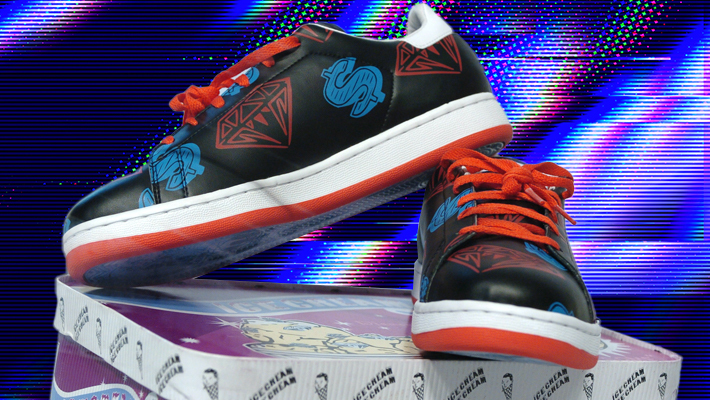
Pharrell Williams doesn’t get enough credit for being lightyears ahead on seeing the linkage between not just hip-hop and streetwear, but the importance of Japanese designers to the medium. Streetwear wouldn’t be what it is today without the influence of Japan, and it was Pharrell who was smart enough to link up with cutting-edge designers like BAPE figurehead NIGO before anyone else. The result was his very own label, Billionaire Boys Club, and the brand sneaker brand ICECREAM.
Pharrell was the first rapper turned sneaker designer, and this pair Diamonds and Dollars silhouette was his attempt at fusing streetwear and skatewear into a single entity. It was a success, it signified a turning point in streetwear that would see the aesthetic completely absorb the world of skateboarding.
Air Jordan 4 Encore, 2004
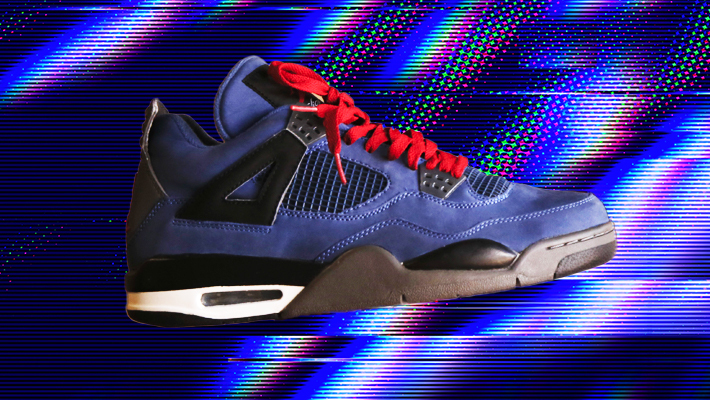
When “My Adidas” and the Wu-Tang Dunks dropped, streetwear was still pretty niche, but by the mid-00s the fashion aesthetic started to hit the mainstream. When Eminem linked up with Nike for the Air Jordan Encore, named after Eminem’s album of the same name, people lost their minds. This shoe single-handedly created the modern sneakerhead.
It remains one of the most popular sneaker colorways of all time, fetching bids exceeding $20,000 on aftermarket sites like StockX and eBay. Nike will occasionally drop a refresh of this sneaker in very limited runs, so it’s still possible to own a pair without paying a fortune for it. Good luck.
BAPE Kanye West Bapesta College Dropout, 2007
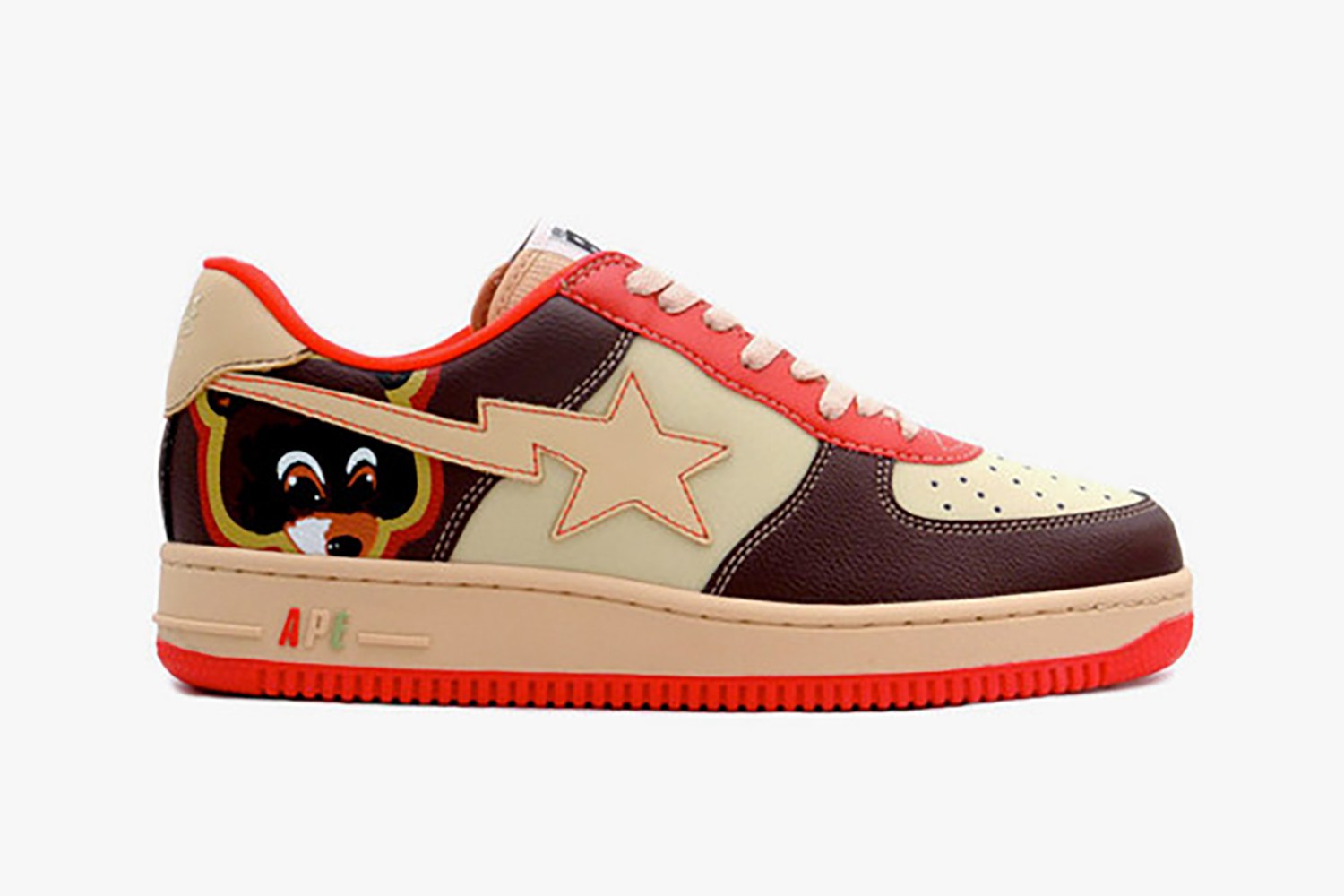
Long before Kanye West had his own sneaker brand, and even before he started calling himself “Yeezy,” West linked up with Japanese streetwear label BAPE for the College Dropout version of the brand’s Bapesta sneaker silhouette. The sneaker features a tan and brown leather upper with red accents and a cartoon graphic of Kanye’s Dropout Bear character.
It’s been a while since we’ve seen the Dropout Bear, Ye ditched the mascot after the “Graduation Album” which was released the same year. It’s a reminder of a younger more playful Kanye and still to this day, a pretty dope design, even if it’s a far cry from what Kanye would design with his own Yeezy brand.
Odd Future x Vans Syndicate Old Skool Pro S Golf Wang Pack, 2013
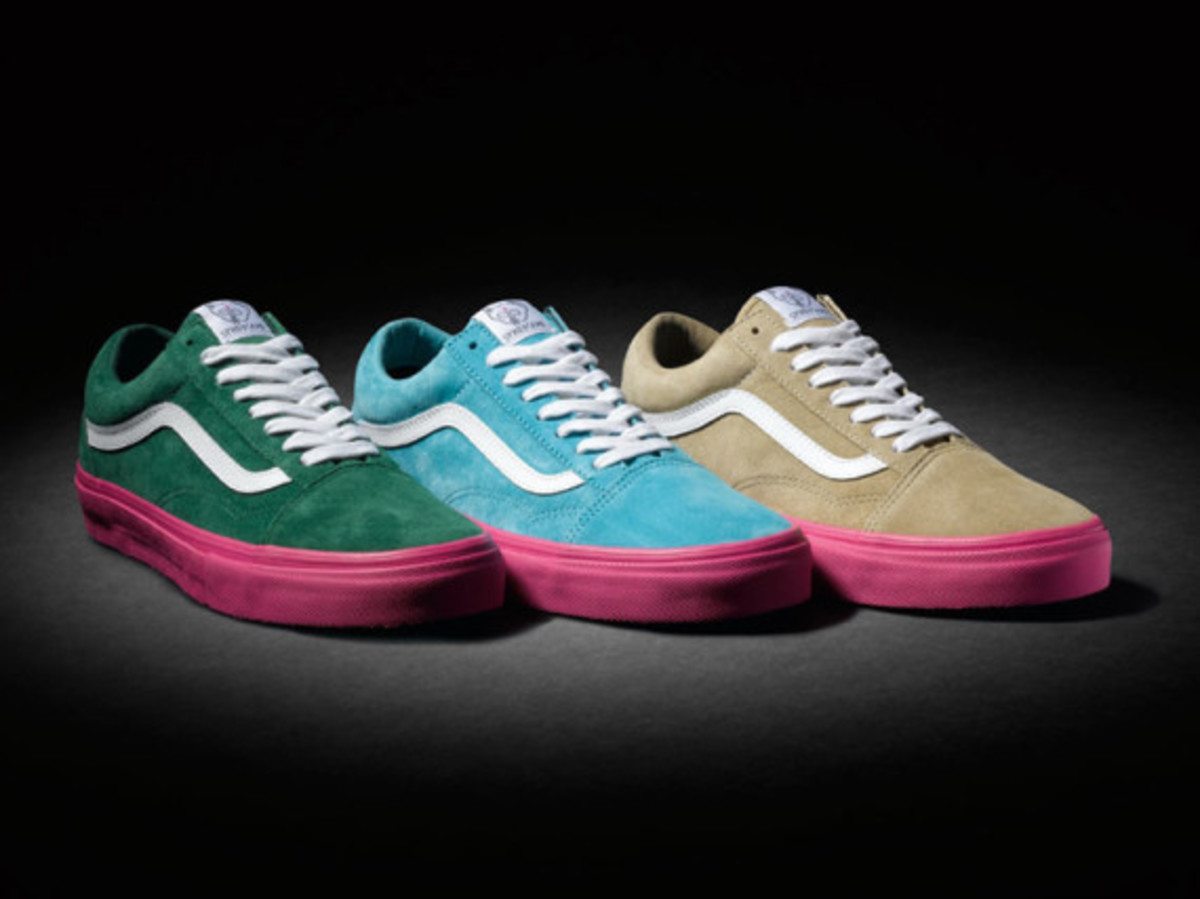
Pharrell combined the worlds of street skating and hip-hop, and out of that came Tyler The Creator’s Odd Future collective. Inspired by the sort of bright color palettes you’d expect out of a Wes Anderson movie and not what you’d find in a typical hip-hop music video (at the time) Tyler The Creator presented his dark strain of hip-hop with a juxtaposing visual aesthetic that forever changed the look of modern rap music.
Before Tyler The Creator, the idea of a rapper wearing a sneaker with a pink sole is something only Kanye West would do, but he didn’t. Tyler did, and this early collaboration with Vans eventually caught the eye of Converse, who swooped up Tyler and gave him his own sneaker line by the name of Golf Le Fleur.
Air Yeezy 2 SP Red October, 2014
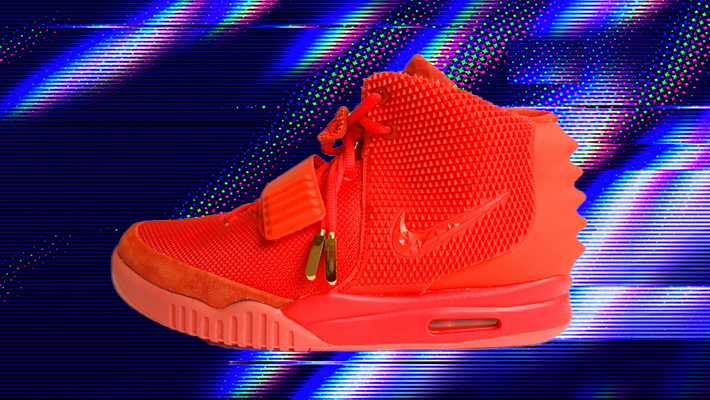
Another Kanye West sneaker? Yes. If you can’t talk hip-hop without mentioning streetwear, you can’t talk about either without mentioning Kanye West. His presence will weigh heavily throughout this roundup. While his cultural status is not quite at the heights it was just seven years ago you can’t deny that the name Kanye West still holds a lot of weight amongst hip-hop fans and sneakerheads alike.
But before Kanye West put his stamp on the world of footwear with his Yeezy Brand, he tried things out with Nike. Ultimately, it didn’t work out (Nike didn’t want to give Ye as much creative control as he wanted) but 2014’s Air Yeezy Red Octobers were the first indication that people needed to take West the sneaker designer as seriously as they took West the hip-hop producer and rapper.
Even today, it’s impossible not to fall in love with this all-over scarlet red colorway. Just look at the thing! Tell us you don’t want a pair.
Air Jordan 12 White OVO, 2016
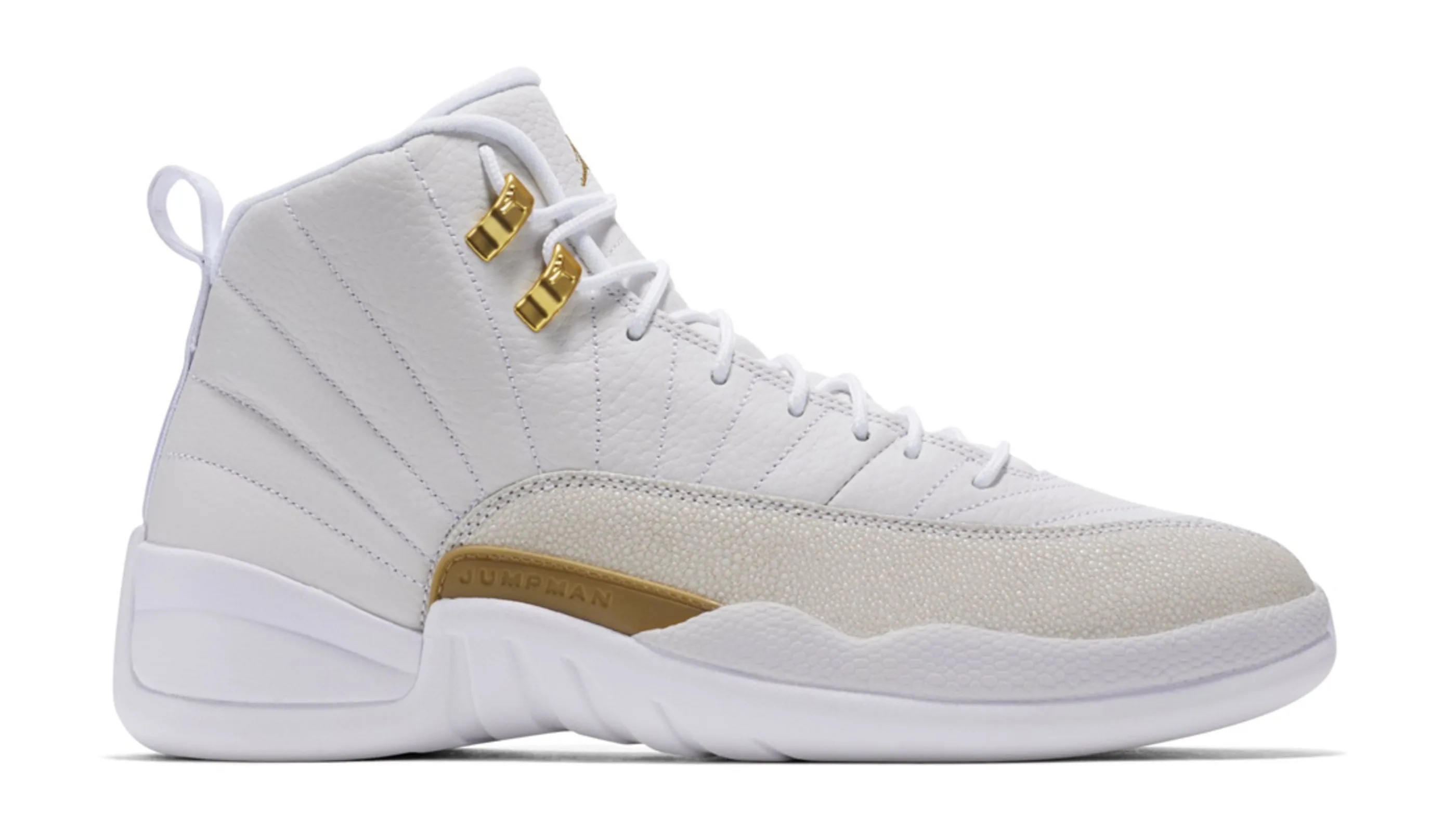
Drake hasn’t had quite the same level of success attaching his name to sneakers as his contemporaries, but the Jordan 12 White OVOs is one of the finest colorways the sneaker has ever seen in its entire run, and it has Drake to thank for that. There is nothing special about this sneaker, Drake didn’t offer up any radical suggestions for a re-design, but what it presents is a highly effective colorway that exudes luxury and class thanks to its mix of white leather and gold accent work.
You can hardly tell Drake has anything to do with the sneaker, and that’s kind of its strength.
Adidas Yeezy BOOST 700 Wave Runner, 2017
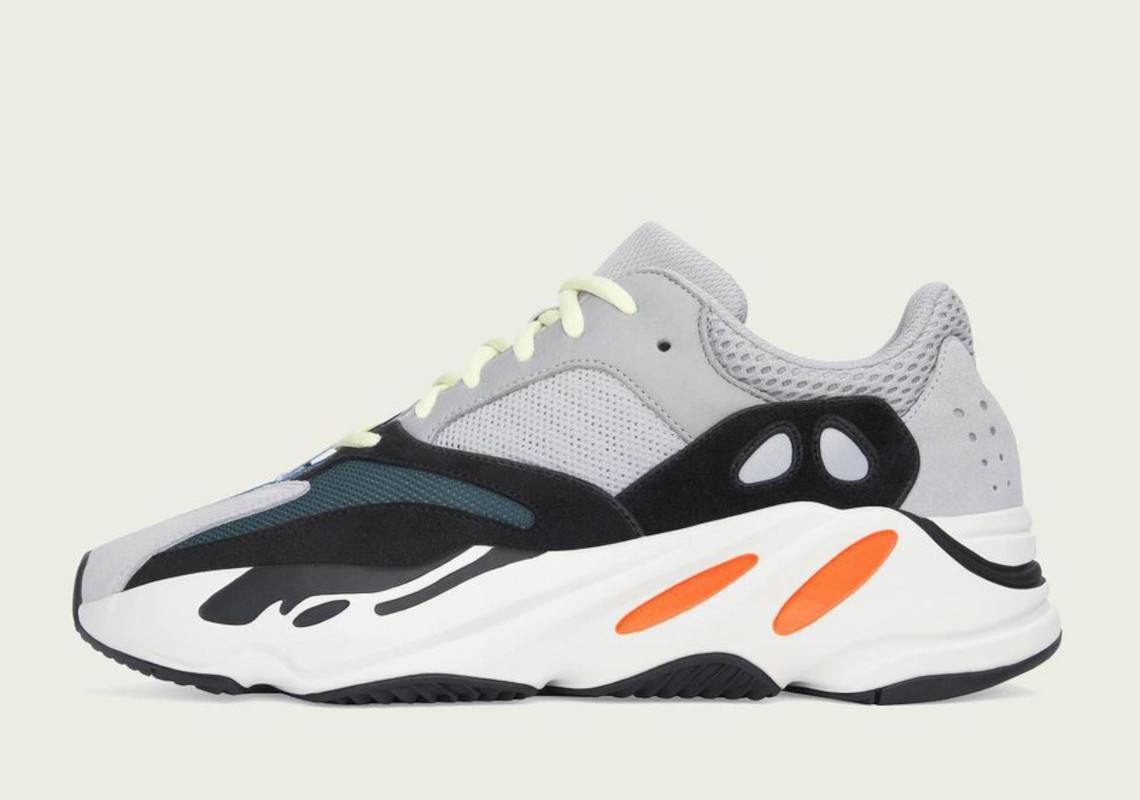
We can’t overstate just how important Kanye West’s name is to the world of sneakers. It’s arguably just as big as Michael Jordan’s, so we couldn’t finish this list without talking about West’s label with Adidas, Yeezy Brand. By 2017 Kanye West and Adidas had already been making sneakers together for five years, but West wasn’t really taken seriously as a footwear designer. That all changed with 2017’s Wave Runner.
When the Wave Runner dropped, which is still the 700’s best colorway, Kanye West singlehandedly made the ‘90s influenced “dad shoe” the hot footwear item everyone had to have. The world of sneakers changed once this shoe dropped, brands like New Balance, Nike, and Adidas started to bring out more of their ‘90s designs and Adidas was able to slash the price of these shoes from the usual $300 to the more affordable (but still expensive) $240.
After the success of the Wave Runner, Adidas themselves started to put more faith in Kanye, increasing the sneaker release runs of all of his future shoes in an effort to make them more accessible amongst the public.
Jordan 1 High OG SP Fragment x Travis Scott, 2021
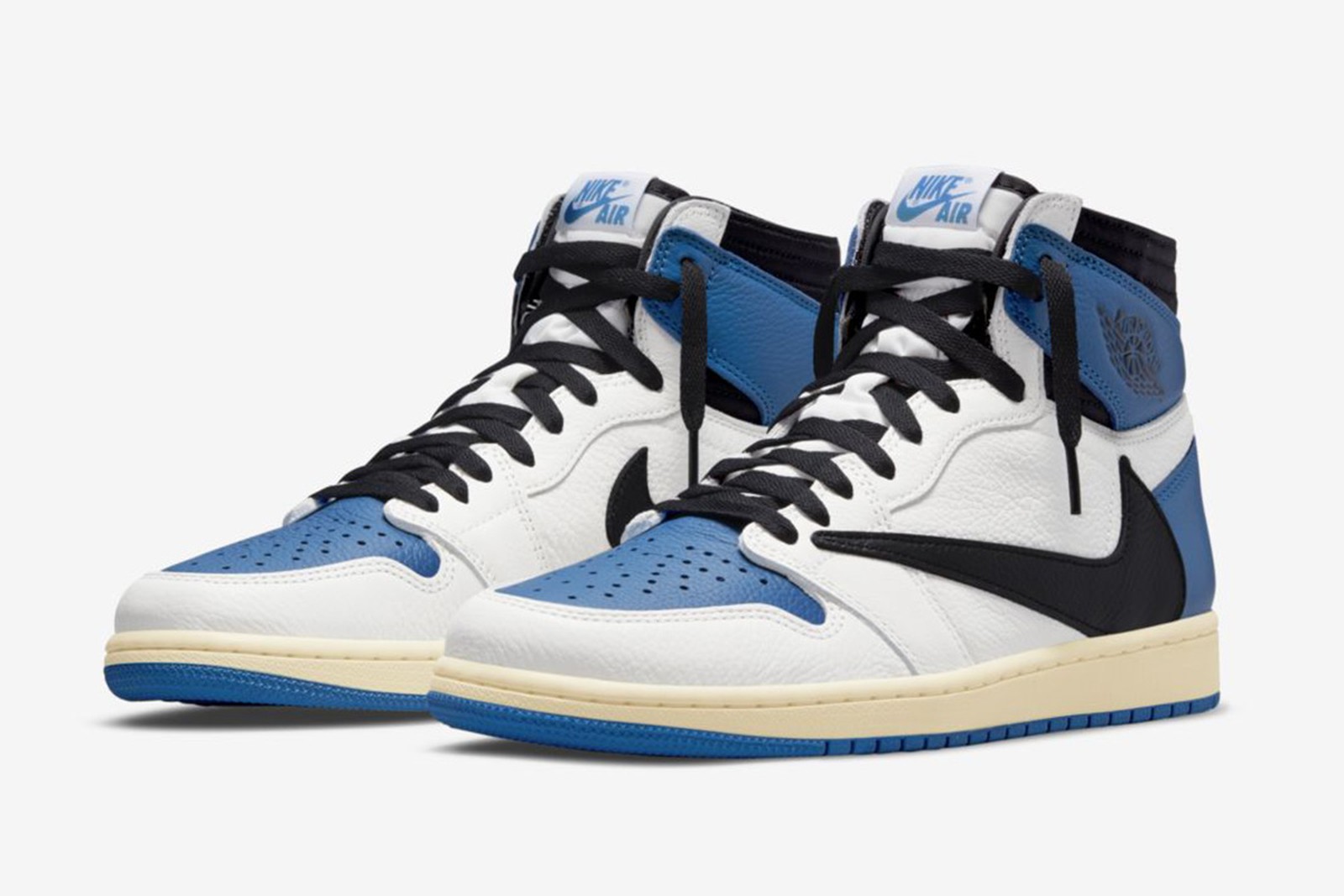
If Kanye West dominated footwear in the 2010s, it’s looking more and more like Travis Scott will inherit that crown for this current decade. This year saw the release of Travis Scott’s 13th Nike collaboration, the Jordan 1 High OG SP Fragment x Travis Scott, a partnership with streetwear label Fragment Design. It’s not the first sneaker people would associate with Travis Scott — that would be the Jordan 1 Mocha — but, and brace yourself for this one, it is the best.
No, it’s not quite as iconic as the coffee-toned Mocha that it’s meant to be a sequel of, but give it time, that combination of University Blue, white leather, off-white midsole, and a black oversized backwards swoosh will no doubt go down as not only one of Travis Scott’s best sneakers but one of hip-hop’s best sneaker collaborations of all time.
Some artists covered here are Warner Music artists. Uproxx is an independent subsidiary of Warner Music Group.
The Greatest Rap Producers Aren’t Dr. Dre Or Kanye West

Virginia production duo, The Neptunes are having one heck of a comeback in 2021. This mighty return has been punctuated by a shout out by Billboard Magazine listing them as one of the Greatest Producers of the 21st century. Pharrell + The Neptunes Have Been Named The Best Rap Producers of the 21st Century In […]
Rappers Who Won the Most Awards
Rappers Going Platinum in a Pandemic
Pusha T Hints At Something Big Brewing With Pharrell

G.O.O.D Music president Pusha T is getting fans pumped about possible new tunes coming together. The hip-hop veteran has lit up social media with a sneak peek of himself linked up with longtime friend and producer Pharrell Williams. Pusha T Hints At Something Big King Push went to his Instagram page with the must-see shot. […]
The post Pusha T Hints At Something Big Brewing With Pharrell appeared first on SOHH.com.
How Has The Music Industry Evolved In 10 Years?

From the rise of the internet, to political and social issues creating a more self-aware society, it’s safe to say that the world has experienced extraordinary shifts in the past 10 years.
Keeping this in mind, it’s not surprising that the music scene would also undergo changes in more ways than one. Each year, music’s biggest hits have carried a distinct style of production which becomes widely emulated, or a theme echoing hot-button topics of conversation. Additionally, industry advancements such as streaming and album bundling have changed the way music is consumed. And of course, social media places the power in the fans’ hands, helping to distinguish who tops the charts.
Ready to take a trip down memory lane? Read on as we look back at some of the biggest music trends and industry changes of the last decade.
2011
In 2011, the sounds of electropop — a hodge-podge of pop, EDM, techno, and dubstep — wash over the industry. Ordinarily viewed as just the “sound guys,” EDM producers Calvin Harris and David Guetta garner top billing with collaborations like Chris Brown’s “Yeah 3X” and “Titanium” featuring Sia. Pop stars like Pitbull and Britney Spears keep fans on the dance floor with EDM-tinged hits “Give Me Everything” and “Til The World Ends.” Kanye West, Jay-Z, and duo LMFAO also combine the electronic sound with their hip-hop and rap-heavy work, evident by Watch The Throne’s “I Can’t Stop” and LMFAO’s “Party Rock Anthem.”
In addition to getting people moving, pop music carries conceptual introspection during this time. This year not only births Adele’s stunning 21, but self-love anthems “Born This Way” by Lady Gaga and “Raise Your Glass” by Pink. Rap — which continues to rise in popularity amongst teens and college-students — also features songs about complex emotions (Lil Wayne’s “How To Love”), pushing through adversity (Lupe Fiasco’s “The Show Goes On”), and life challenges (Diddy-Dirty Money’s “Coming Home”).
2012
In a near-180 from the previous year, alternative rock and indie pop reigns supreme. Gotye’s “Somebody That I Used To Know” is the year’s best-selling song, and the band Fun dominates critically and commercially with their album Some Nights, lead by “We Are Young.” Neon Trees, Bon Iver, Alabama Shakes, and Mumford and Sons break new ground with their respective projects and accolades.
Internet virality (a trend which won’t be uncommon in the years to come) also goes to new heights. “Somebody That I Used To Know” sees a slew of covers and music video parodies upon its release, while Carly Rae Jepsen’s “Call Me Maybe” becomes an internet sensation. South Korean artist PSY’s “Gangnam Style” is so popular, it results in a change to how songs are considered for Billboard’s Hot 100 chart. Per the Harvard Business Review, tracking “listens” through YouTube videos now factors into the chart’s ranking methodology.
2013
In 2013, top-notch production is the name of the game. Hit tunes are balanced between show-stopping sounds (Macklemore and Ryan Lewis’ “Thrift Shop,” Avicii’s “Wake Me Up”), nostalgic instrumentation (Daft Punk’s “Get Lucky,” Robin Thicke’s “Blurred Lines,” Bruno Mars’ “Treasure”), and minimalist stylings (The Lumineers’ “Ho Hey,” Lorde’s “Royals”).
This year also marks the beginning of the end for digital singles and iTunes in favor of streaming, and emphasis on “vintage” ways of buying music (vinyl), which decreases the importance of CDs and pure album sales. Per Billboard, “digital track sales fell 5.7 percent from 1.34 billion units to 1.26 billion units, while digital album sales fell 0.1 percent to 117.6 million units from the previous year’s total of 117.7 million.” Non-traditional album and CD merchants like Starbucks, Urban Outfitters, and Amazon see an increase to 36.5 million units sold, in comparison to the dwindling sales of indie merchants (a drop of nearly 12 percent).
2014
While empowerment pop has always been popular, uplifting themes of self-confidence carry 2014. Children and adults enjoy songs that make them feel seen and accepted for who they are. Kids gravitate to Despicable Me 2’s “Happy” (performed by Pharrell Williams), while members of the LGBTQ+ community christen a new anthem with Ariana Grande’s “Break Free.” Taylor Swift’s new pop-heavy sound also provides a message for haters: “Shake It Off.”
Songs about body positivity are also popular. The surprise drop of Beyoncé’s fifth studio album in winter 2013 gives listeners a new catchphrase for 2014 — “I Woke Up Like This” from her song “***Flawless.” Nicki Minaj and pop star Megan Trainor drop songs about pride in their prominent posteriors with “Anaconda” and “All About That Bass.”
2015
Electronic dance music is taking over the scene again. This time, a recognizable characteristic — the drop — is center stage. This sudden change in sound or rhythm is central to hit songs both by EDM-leaning producers (Major Lazer’s “Lean On,” DJ Snake’s “You Know You Like It,” Calvin Harris’ “How Deep Is Your Love”), and pop stars (The Weeknd’s “I Can’t Feel My Face,” Demi Lovato’s “Cool For The Summer,” Zara Larsson’s “Never Forget You”). The trend continues into 2017.
This year also kicks off the re-emergence of viral dance crazes, which continues into 2021. Bruno Mars and Mark Ronson steal the show with “Uptown Funk,” while Drake becomes a meme for his moves in “Hotline Bling.” Silento’s “Watch Me (Whip, Nae Nae)” and iLoveMemphis’ “Hit The Quan” become fixtures on and offline.
2016
Dancehall and Caribbean-inspired tracks are a mainstay in 2016 pop. While Justin Bieber’s “Sorry” was released at the tail-end of 2015, it is the biggest song of 2016, per Billboard. Drake leans into this craze with his hits “One Dance” and “Too Good.” The latter is a collaboration with Bajan musician Rihanna, who drops a whine-inducing ditty, “Work,” also featuring Drake.
Additionally, Ariana Grande, Sia, and Clean Bandit create hit songs with island flavor: “Side To Side,” “Cheap Thrills,” and “Rockabye,” respectively. This trend continues until at least 2019, however, as conversations of cultural appropriation of Black music heat up, these sounds taper off. Per The Observer, modern dancehall music has always been appropriated. Reggae/dancehall superstar Sean Paul says in the interview: “It is a sore point when people like Drake or Bieber or other artists come and do dancehall-orientated music but don’t credit where dancehall came from and they don’t necessarily understand it.”
2017
R&B/hip-hop surpasses rock music as the most-listened to genre on the planet, per Nielsen Music. Its supremacy becomes exceedingly evident in 2017 with the takeover of the trap sound—classified by heavy bass, atmospheric sound and brash attitude. Migos, Future, and Rae Sremmurd’s popularity soars with trap hits “Bad And Boujee,” “Mask Off,” and “Black Beatles,” while social media superstar Cardi B breaks the mold with her major-label debut single, “Bodak Yellow.” Soundcloud-style trap rap, which employs a more ethereal, trippy sonic inspiration, is found in Post Malone’s “Congratulations” and Lil Uzi Vert’s “XO Tour Life.” The trend continues into 2018 with Juice Wrld’s “Lucid Dreams.”
Given a tepid national climate, songs featuring socially-conscious and self-aware themes become popular. Rapper Logic’s experiences with depression prompt him to pen the rap/sung collaboration “1-800-273-8255,” which increased calls to the National Suicide Prevention Lifeline by more than 30 percent. Alessia Cara, a featured artist on Logic’s song, releases her self-love anthem “Scars To Your Beautiful.” Kesha drops “Praying” in the hopes that the abused and their abusers can heal. The song was written in response to the alleged sexual assault and emotional abuse she’s experienced at the hands of producer Dr. Luke.
2018
Due to the success of Luis Fonsi’s monster hit “Despacito” the year prior, it’s no surprise that Latin pop and hip-hop completely command the airwaves in 2018. J. Balvin’s “Mi Gente” and Camila Cabello’s “Havana” were released in 2017 and continue to have chart success this year. Cardi B’s Latin-heavy rap track “I Like It” hits No. 1 on the Billboard Hot 100 charts, while Becky G, Marc Anthony, Will Smith, and Bad Bunny drop “Mala Mia” and “Esta Rico,” respectively.
2018’s crossover collaborations also find unexpected success. Zedd and Maren Morris’ ‘The Middle” receive Record and Song of the Year nominations at the 61st Grammy Awards. Florida Georgia Line and Bebe Rexha’s “Meant To Be” hits No. 2 on the Hot 100 chart, and DJ Snake’s “Taki Taki” featuring Selena Gomez, Cardi B, and Ozuna reaches one billion streams on Spotify.
2019
The theme of 2019 is that…there is no theme. Genreless music — sounds that fit an artist’s mood, vibe, or idea without boundaries or confines — encapsulates the music world. Newcomers Billie Eilish and Lil Nas X shatter expectations with “Bad Guy,” (an electropop, hip-hop-flavored dance track) and “Old Town Road” (a record-breaking country trap hit). Music superstars Ariana Grande and Tyler The Creator also take part in the sonic shattering. Her song “7 Rings” pairs Broadway with trap, while his song “Earfquake” combines R&B, hip-hop, and soul.
Self-love anthems also make major comeback, and highlight the various levels of self-acceptance. Panic! At The Disco’s “High Hopes” is about self-confidence. Self-love and exploration is the base for Selena Gomez’s “Lose You To Love Me” and Ariana Grande’s “Thank U Next,” which was popular in 2018 as well. Through her album Because I Luv You, Lizzo proves that spreading positivity is her M.O.
2020
Nothing captures 2020 in music quite like social media’s reign over the charts. TikTok, a popular video creation app, is the place for viral dance crazes to take over. Routines to Doja Cat’s “Say So” and Megan Thee Stallion’s “Savage” boost their popularity, while the dedication of Internet stans catapults Lady Gaga and Ariana Grande’s “Rain On Me” and BTS’ “Dynamite” to the top of the charts.
Despite strict social distancing rules in the age of COVID-19, dancefloor-ready tunes are an undeniable trend. Dua Lipa rules the year with her album Future Nostalgia, and “Say So” carries palpable ’70s-inspired energy. Other disco-tinged hits include Jessie Ware’s “Remember Where You Are,” Kylie Minogue’s “Say Something,” and Victoria Monet’s album Jaguar.
2021
There haven’t been too many distinguishing music trends as of late. (Especially since it feels like we’re still in 2020.) However, it appears that budding music stars are about to make their mark.
Since the beginning of 2021, singer-songwriter Olivia Rodrigo’s song “Drivers License” has been on top of the charts, and “Mood” by 24kGoldn and Iann Dior has held the second seed position for several weeks. Relative newcomers may also find success if they continue to collaborate with major stars, such as singer-songwriter Jhay Cortez with “Dakiti” (his collaboration with Bad Bunny), and rapper Yung Bleu with “You’re Mines Still” (his link-up with Drake).
Some artists covered here are Warner Music artists. Uproxx is an independent subsidiary of Warner Music Group.
Blink-182 Got Grimes, Lil Uzi Vert, And Pharrell On Their Next Album
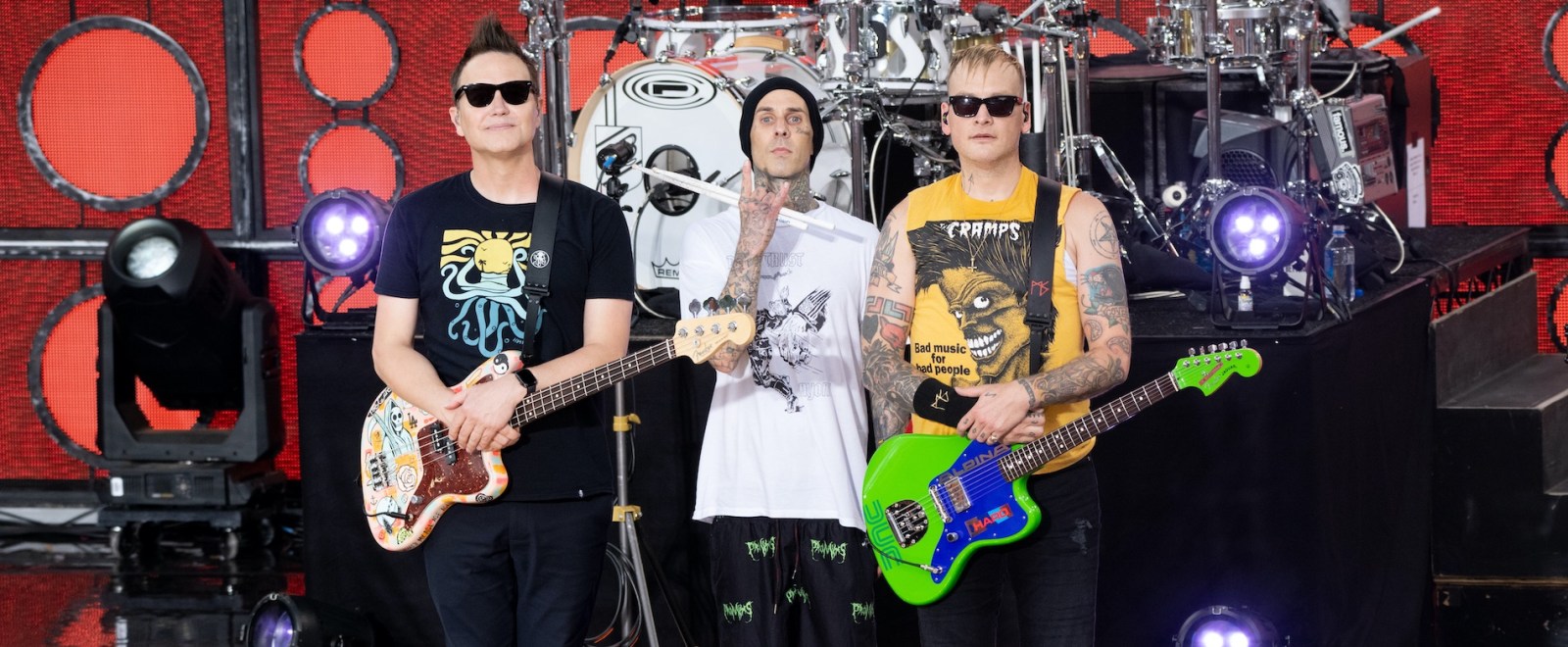
Travis Barker does a ton of collaboration outside of Blink-182, but that doesn’t happen as frequently with the band. Barker has revealed, though, that for the next Blink album, they have been working on songs with Grimes, Lil Uzi Vert, and Pharrell.
On a recent episode of the Rock This With Allison Hagendorf podcast, Barker said the album is about “60 percent” done and added, “There’s a lot of cool stuff. There’s like a song with Grimes right now that’s really, really cool that I love. There’s a song with Uzi that’s really, really cool that we did with Pharrell.” He also said:
“I mean, it’s not like Blink’s making a rap song or anything. It’s like bringing Uzi over to our world. So it’s more of a punk kind of like reggae-feeling song. And yeah, I mean, I don’t think Blink will ever be anything but like a pop-punk band. I mean, that’s who we are. And I feel like our fans have kind of journeyed with us when we’ve done songs like ‘I Miss You’ or ballads like ‘Adam’s Song.’ But like we’re never going to veer too far off from what we are — like, I’m like a punk kid at heart, you know what I mean? Whether it’s like pop-punk with Blink or whatever with [Machine Gun Kelly] or whatever with Trippie [Redd], that’s where my heart’s at. Like, I was raised on rap music and punk rock music. It’s kind of all I know.”
Listen to the full Rock This episode below.
